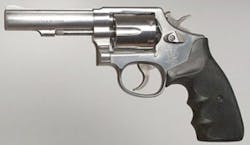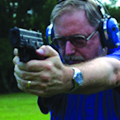In Part One of this discussion about handgun safeties, I hope I made my point about firearm safety being primarily a matter of intelligent and careful gun handling, rather than a result of any particular mechanical device. I got on this subject because I talk to many people who seem to feel that some type of manual safety is needed on a handgun and the mere presence of such a feature somehow makes a gun safe. Again I say: safety is achieved through user competence.
Whether a specific type of safety is a help or a hindrance depends on how well the user understands the device and how well trained he or she is in its use. In selecting duty handguns, law enforcement agencies usually are trying to walk a careful path between effectiveness, simplicity of use and covering themselves in the liability department. There are various mechanical features that can enhance safety, when used properly. Before I go there, however, I think it is appropriate to cover a brief bit of police firearms history.
The traditional double action revolver was the gun of choice for most law enforcement agencies for many decades. It was an ideal tool because it was simple to operate and the long and heavy double action trigger pull, though not the best for accuracy, did prevent most accidental discharges. Trouble began immediately, of course, when the revolvers were manually cocked into single action mode. Most accidental shootings occurred when someone had their finger on that trigger, which now had a very short and very light pull, and they were bumped, startled or just plain shaky from whatever the incident was that caused them to draw the gun in the first place. Many agencies addressed this problem by altering their revolvers to fire double action only (DAO). Eventually someone figured out that keeping your finger off the trigger until you actually intend to fire the gun would be a good thing, and we are still trying to make that idea a universal practice to this day.
Things started to change when police agencies began to seriously consider the adoption of semi-automatic pistols for regular service use. Various auto loaders had certainly seen limited law enforcement service ever since they were introduced, but the simplicity of the revolver kept it as the primary duty handgun until the police began to feel outgunned by the criminals. The increased capacity and faster reloading capability of the semi-auto pistols simply could not be ignored. At the time, the two pistols that received the most attention were Colt's 1911 Government Model (and its variations) and the Smith & Wesson Model 39. There were others, of course, but for those of us who were there, these two were the only serious contenders. I mention them here mainly to make the point that each had built-in safety features that are still with us and are still much debated in their usefulness to this day. The reason they had those features, of course, was to prevent accidental firing of the gun and each firearm design approached that problem from different engineering directions.
The single-action only Colt pistol, designed by John Browning, was introduced as a military sidearm in 1911 and it certainly served with distinction in that role. It didn't gain a lot of traction with the police community because it was designed to be carried cocked-and-locked (also called Condition One), meaning with a round in the chamber, hammer fully cocked and the manual thumb safety on. To further enhance the safety of this precarious looking condition, the Colt also had a grip safety. While Condition One was a good way to carry the pistol in combat, it somehow just didn't look right in polite society and nervous police administrators realized that once the gun was drawn and the safeties deactivated, they were back to that very light trigger pull that caused so much trouble with the revolvers. In order to use a gun like this safely, training would be much more complicated and expensive. Only the truly intrepid would walk this path for many a year and I considered myself truly fortunate to be with an agency that, back in the early 1970s, adopted the Colt as our standard sidearm. What seemed to stick in people's minds about the design was that manual safeties and semi-auto pistols just went together, no further questions asked.
The more popular alternative for police use was the Smith and Wesson Model 39 semi-auto pistol. It incorporated safety features that had already been available on other pistols, such as the double action/single action (DA/SA) trigger operation of the Walther semi-auto pistols and the magazine disconnect safety that was in use on the Browning Hi-Power. It also had a manual thumb safety, but it was mounted on the slide instead of on the frame, like the Colt or the Browning. This also served as the de-cock lever, allowing the hammer to be lowered safely on a loaded chamber, leaving the pistol in double action firing mode. It could be carried either with the safety on, which meant that the shooter's thumb would have to deactivate the safety prior to shooting the gun, or the safety could be left off and the first shot would be very similar to the familiar feel of a revolver. After that first round, however, the pistol remained in single action mode for any additional shots, unless and until the shooter intentionally lowered the hammer with the safety/decock lever. Things were getting more complicated.
Before I wrap up this history segment, the Browning Hi-Power deserves a brief digression. It was a superb single-action-only pistol, also designed to be carried cocked-and-locked. But, unlike the earlier Browning-designed Colt, it had no grip safety. As mentioned above, it did have a magazine disconnect safety, which means that the gun would not fire when the magazine was removed, even with a live round in the chamber. It also had one other feature that would dramatically influence police firearms design in the years to come: a higher capacity magazine. The Hi-Power, being a 9mm, had 14 rounds (13+1) in a gun with a very comfortable grip. The Belgian-produced Hi-Power became wildly successful in other parts of the world. Indeed, it is still in service in many places today but it never really caught on here in the States. However, it did influence how we viewed both safety features and capacity, so it deserves mention here for the purposes of our safety discussion.
This is certainly not a comprehensive history of police firearms, but I'm just trying to set the stage to review the different approaches to mechanical handgun safeties. As we discuss them in future segments, it should be helpful to understand how they came into service on police sidearms and why some people cling to the idea that the mere presence of one or more safety devices means that a gun is somehow inherently safe. Actually, all guns used in police service are inherently safe... until someone starts handling them. Then, once again, things become more complicated.
About the Author
Steve Denney
Steve Denney is a former municipal police sergeant, USAF Officer and chief of security/safety officer for a large retirement and healthcare community. A former SWAT officer, crime prevention officer and both military and police firearms trainer, he is currently an instructor for LFI Judicious Use of Deadly Force, LFI Stressfire, and NRA and other defensive tactics disciplines. He currently trains police, military and private citizens. He is a charter member of ILEETA and a member of IALEFI.

